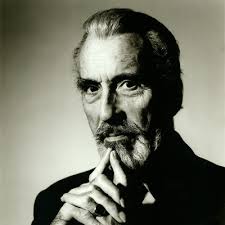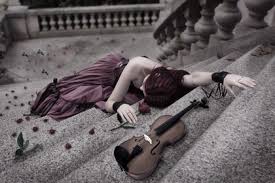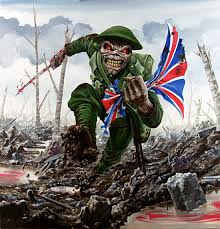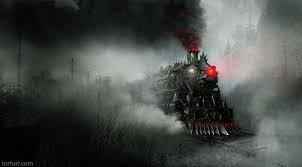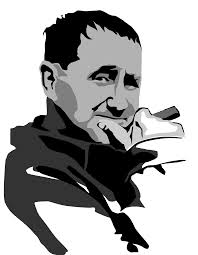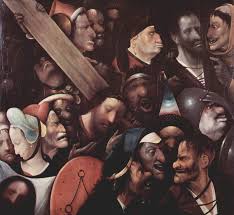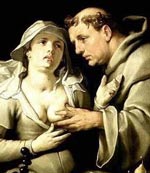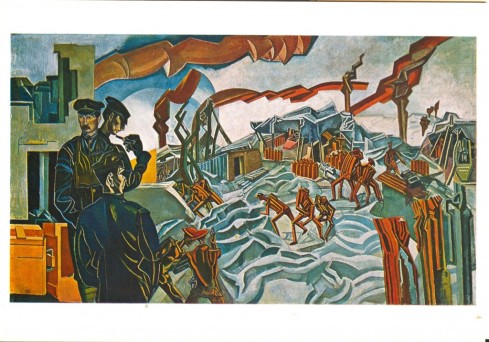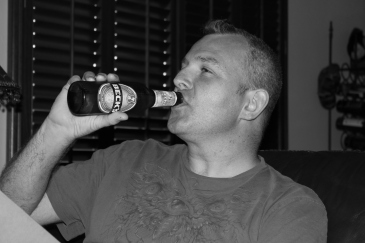Instruments of Devotion and the
Demise of the Icon with the Advent of Lollardry
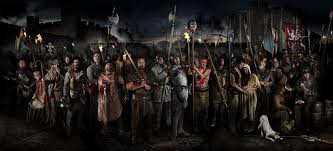
The idea that an image can convey a message is nothing new; in fact, the genre that society has become so familiar with through the medium of film and graphic novel can probably trace its roots back to the cave paintings in Lascaux in France. Although early man was illiterate, he was able to convey that which was important to him through imagery. In Lascaux we see images of what appear to be hunters chasing wild animals, many of which are now extinct. The only surviving record of them apart from their inanimate presence in the fossil records is the extraordinary animation they retain, despite the millennia they have endured, on the lime stone walls of the French caves. Just as primitive man wished to convey a message, so did those living in the Church-centric world of the Middle Ages. Despite the fact that literacy as a medium was not as prominent in the laity of the period, there existed a strong alternative through which “necessary” information could be conveyed. In exploring the significance of the medieval icon one can begin to understand the willingness with which it was accepted and the utility it supplied in supporting the hegemony of the Catholic Church. Not only did icons help to maintain the defacto power of the institution through their spiritual and financial exploitation, they also gave rise to a Reformist voice in the form of Lollardry. By comparing and contrasting both the importance and the controversy that surrounded reliquary and iconography and the reformist teachings and movements of the period, it is possible to identify some of the many reasons that led to the eventual collapse of the spiritual monopoly enjoyed by the Catholic Church.
The medieval period bore witness to the sacerdotium, the earthly priestly hierarchy responsible for the salvation of souls. This meant that not only was the heavenly salvation of the public, via their earthly wealth, up for grabs, but so was their usefulness via their tacit acquiescence. In order to achieve these ends there had to be a means by which the people of the period, either through cognitive dissonance or religious indoctrination, would allow themselves to be manipulated. Through the coercion of Biblical readings, textual exploitation and most importantly iconography, the church was able to maintain its position of dominance and remain at the center of medieval life for many centuries. It’s the importance of iconography both literal and physical that is significant.
According to Yale professor Keith Wrightson, who lectures on early medieval Catholicism in England, there were “myriad examples of functional iconography to be found within the churches and cathedrals of the period, where beautiful examples of medieval art were available to a God fearing public.” (115) In particular the cathedrals of Ely, York and Durham offered the illiterate laity a visually rich religion. Access to God for the common man was through the Church and its sacraments and in particular through partionary prayer. By offering gifts or by venerating icons the supplicant was able to ask the painted, plaster saints to intercede with God on their behalf. Given that there was widespread illiteracy amongst the contemporary public and that the Bible was only available in Latin, the conveyance of the Biblical narrative was most successfully achieved through visual representation. “Rood screens, paintings, statues and religious relics were all stock-in-trade pedagogic ephemera to the Catholic Church.” (122) The Stained glass windows, for example, in Exeter Cathedral depict in seven glass panels the wounds of Christ interconnected to images of the seven sacraments and served as a focus for congregational education and veneration. “The contrived link,” writes Wrightson, “between Christ and the Church precipitated community participation and a general understanding of what it was the Catholic Church was trying to convey.”(137) Similarly the devotion to the shrines of particular saints is well documented and those of Thomas Becket at Canterbury Cathedral and the great shrine of Saint Cuthbert in Durham were both important destinations of medieval pilgrimage. “Pilgrims would decorate icons with rosary beads and offer gifts for the dressing of statues… in the account books of contemporary church wardens the wills and generous donations of prominent parishioners can be found for the beautification and restoration of alters and chapels dedicated to favorite saints.” (136) The Christian religion of the medieval period lent itself to the aphorism that an image was representative of a thousand words and therefore, was nothing if not opulent.
Although the word of God in the form of the Bible was of primary importance in proliferating Christianity, it was the instruments of devotion that helped to spread and sustain the faith. Concrete, albeit painted, evidence of a divinity that existed beyond the constraints of an earthly realm was necessary in order to excite the imaginations of the faithful and ensure sustained obedience to the teachings of the Church. This was demonstrated in ways which are still accessible to contemporary scholars. The iconography of the period hangs in museums and galleries, the tales of pilgrims on the road to Canterbury can be found in our libraries and the objects of medieval adoration can still be seen to this day in many European cathedrals. Instruments of Devotion deals with the subject of iconography, its effect and its social, religious and political importance. The book edited by Henning Laugerud and Laura Katrine Skinnebach delves into the practices and objects of religious piety from the period of the Late Middle Ages onwards. This collection of lectures and essays, through which the editors offer well-researched historicism, documents the importance of religious imagery to both the Church and those who viewed it. The book describes in detail, what to contemporary society may appear as simply pictographs, the complex, instructional medium that helped to bind the common man to the Church and helped maintain it in its position of preeminence during a historical period when Christianity was at the center of public life. People lived in a God-centric universe defined by preordained estates and owed their allegiance and prayers to those who existed beyond the mortal plain. According to Laugerud, “… life on earth was simply the interim of hardship before the reward of eternal bliss.” (6) This being so, it was the duty of the Church to inform those of their congregation who were inevitably destined for heaven or hell of their options and what could be done on earth to assuage the demons of mortality and insure the angels of grace. By means of “visual theory,” (7) pictographs and artistic impression developed into a viable means of medieval pictorial technology. Successful information dissemination was therefore established via the medium of art.
The chapter Piety, Practice and Process which references an excerpt written by Henrik Von Achen, deals with the phenomenon of a rewarded life, where Henrik proposes that human redemption is not encapsulated within the limits of the soul but rather, that salvation was accessible through “books, pictures, music, and liturgical practices.” (24) Von Achen suggests that piety can be studied through the instruments of devotion that were utilized during the period. This being “true,” the religious ephemera which we still see in our modern society takes on a whole new meaning. Rather than gaudy, expensive and over expressive, the icons that have survived can be seen at their most basic as instructional and at their most sinister as religious propaganda. The traditions of “spiritual deference” (13) embodied within medieval art are an “important ingredient” (13) in understanding the medieval psyche. Von Achen suggests that “the instrument, or image, played a constitutional role in creating that special, intense, and existential meeting between God and the individual believer,”(14) and so rather than just color on canvas or paint on brick, iconography was fundamental in what we today recognize as faith. Modern Christians may also speak of faith whereas the medieval characterization of the same religious emotion would be devotion or objectified fetishism; something which is still very apparent in the contemporary Roman Catholic Church.
Given the position of the Church and its rivalry with monarchy in the temporal hierarchy of the estates, their ability to communicate and show the message of God would have been akin to being the owner of the only newspaper in town. Equally able to repress and promote the pertinent message of the hour, the Church was the sole source of doctrinal dissemination and the Rupert Murdoch of its day. In order to popularize their ideas, themes were a very important part of illumination. Recognizable Biblical characters and religious tracts were incorporated into art with the addition of recognizable human emotion. For instance, the image of the heart which we see time and again in clerical imagery is one that has been coopted to represent so many different things. In particular, in the iconography of the period, man’s immediate access to God through means of either Grace or heartfelt prayer. In ancient cultures the heart had consistently been seen as the source of reason but instead rose to prominence in the late medieval period as the center of human emotion, something with which our own society is still familiar. Iconography created a common ground that reflected on the relationship between the art and the supplicant instead of the dogmatic teachings that had been common in earlier religious education. (27)
The Medieval citizen, according to the essays edited by Flemming in the work Medieval Iconography and Narrative, “had a more inclusive concept of reality [and] … saw much more than we do.”(187) Knud Banning, one of the collected essayists, proposes that a modern day visionary is understood to see beyond what is the norm and in this sense can be applied to medieval supplicants of religious art. His essay, The Book and Church Wall, goes even further and boldly states that during the period, visions defined reality and that religious art was a means of “giving their own mysticism [substance and even] credibility. (187) Banning points out that although the experience of God is not within the art, it is the art that provoked the sense of Christ that was used as an aid to visualization during private moments of devotion and prayer. The evocation of Christ through familiar religious symbolism would probably have stayed with the devotee for the rest of their life. Hence, the importance of icons in rural churches, as well as those to be found in major centers of population. No matter the location and despite the fact that most congregations wouldn’t have been able understand the Latin used during the sermon, there would have existed a religious affinity, albeit with an individual image emblazoned upon their memory.
“The importance of images had to do with the importance of sight and vision and their connection with knowledge and understanding.” (173) Fleming focuses particular attention in several of the collected essays to impress the idea of a story-board iconography that could impart this idea. The concept, for instance, of the painted Triptych which can be found in so many of our Cathedrals and galleries today is not an artefact of artistic whim, but rather a means of apportioned learning. The book delves into the process of conquering souls through intense focus, where the Triptych could be separated and used, much as a teacher uses a black-board, to educate congregations. Not only was it utilitarian in its pedagogical sense, but it was also a point of focus for prayer and supplication. Rather than an ephemeral, stylistic image of God in his heaven, a universal icon was available that could create a sense of unity and community. It wasn’t for nothing that pilgrims would progress to distant destinations to view a remarkable mural or observe a particular relic. It was precisely the visual that was their reward for their ardors and a moral boost to their already keen sense of what they believed: the imagery confirming their own “true” paths and ultimate destinations. According to the essay The Role of the Frontispiece or Prefatory Picture by Elizabeth Salter and Derek Pearsall, medieval scholars understood that “the theory of visual cognition became the common ground for all theories of vision in the Middle Ages.”(175) Saint Augustine writes in The Confessions, as they remark, “that sight is the chief of our senses in the acquisition of knowledge and is… the divine language”(175) and the modern aphorism of “a lust for the eyes” can be found in Augustine’s fifth century writings, although this was first emphasized in the Gospel of Saint John, which helped develop Augustine’s later comments on the importance of sight, when John writes, “For all that is in the world, the lust of the flesh and the lust of the eyes and the boastful pride of life, is not from the Father, but is from the world.” “The act of seeing was both a sacramental aspect and an aspect of identification.”(180) By persevering with the idea that religious devotion as well as religious hegemony were of major importance to the Church, the book continues to define the icon as not simply a work of art but as an “instrument of piety”(180) utilized as a medium for the “transference of grace.”(180) But this is perhaps a one sided view.
The medieval period is renowned for the ecclesiastical iconography that framed both the ambition of the Catholic Church and its ability to maintain control over a servile population. Given that the tools of the trade were in the hands of Mother Church, one can easily envision how the ignorant masses were psychologically coerced: a classic example of knowledge being the key to power and the mysterious revelations of all things Biblical existing as the only moral route to heaven. In a society that was both controlled and ruled by the Church, an illiterate lay population would have been relatively easy to manipulate through the power of iconography and strict adherence to Church doctrine. The perception that clerical truth was the only tolerated truth was implemented via the teachings of the Church and through the iconic representation of religious lore. Professor Wrightson describes the resentment felt by those eager for the reform of an institution “that failed to castigate pride and worldliness, especially within its own organization.” (142) The use of religious icons to generate clerical wealth went far beyond scripture and consequently was unrepresentative of the teachings of God.
One such dissenter to these contrived teachings, writes Christ Von-Wedel, was Erasmus of Rotterdam, “a seminal figure in the proto-protestant movement, whose ideas and dissatisfaction with the Catholic Church gave rise to the advent of other dissidents such as John Wycliffe and the Lollard movement.”(64) Erasmus, she states, was hostile to the privileges extolled by the Church and recognized the reverence to guilded saints as fraudulent and idolatrous, purgatory as a false doctrine and sermons for souls as a racket based on a misappropriation of Biblical authority. As Erasmus was keenly aware, the worship of imagery was bound to induce clerical corruption given the esteem with which they were held by a supplicant laity. Erasmus of Rotterdam was a man more interested in a Bible centered faith than religious fetishism and famously remarked “that with all the true splinters of the cross to be found in the churches and cathedrals throughout Europe, there were probably enough to rebuild Noah’s Ark.” (66)
This search for true faith, writes Dean, is evident in the anticlerical literature of the period and the denouncement of religious orders, such as the friars, in their ability to adhere to the pious lifestyles they proposed for others. William Langland’s Piers Ploughman is vociferous on this issue and can be read as a polemic in its clerical views and recognized as a piece of “early” propaganda for a religious alternative to the Catholic Church. “Langland’s narrator,” writes Dean, “consults friars – a Franciscan, a Dominican, an Augustinian and a Carmelite, respectively – hoping to learn what he calls the “graith,” the plain truth, but is dismayed that the friars instead denounce the rival fraternal orders or try to dun him for money.” (15) Langland writes of the familiarity the laity has with the clerical devices and the icons of the church, but of the inability of the individual to delve deeper into the true theology of the Bible.(15) Langland’s dreamer remonstrates that many people know their prayers, their specific saints and canonical responses but little else. Dean points out that, “The implication is that the friars do not know the Creed, which was a charge often leveled against the fraternal orders.” (16) Awakening from the cognitive malaise in the belief of the power of the Church, Langland’s protagonist recognizes in himself that there is more to scripture than is being represented by the clergy and that the way to God is not through the veneration of reliquary and pilgrimage but through truth and personal spiritual supplication as witnessed by his quest for the characters of Lady Study, Clergy and Scripture.(90) The engagement with something deeper mirrors the concerns voiced by Erasmus and later by John Wycliffe and Martin Luther. There is an awareness, writes Langland, of kynd – “the father and maker of everything ever made” (87) – of something else, of an existential preexisting relationship between man and God that transcends parables, decorated alters and pilgrimages.
The later emphasis given by the Church to the Ten Commandments instead of the Seven Deadly Sins, to the eventual detriment of the Church’s own hegemony, also reflected a conscious movement towards a tangible God, as evidenced by the first three of the commandments in the Decalogue that are all concerned with disavowing idolatry: a misstep perhaps of naïve, pious intent on the part of the Church? The earlier teachings of the Church, Bossy writes, as proposed by Augustine, were later accepted, along with the new moral code represented by the Ten Commandments, by both the Catholics and Lutherans, which included the prohibition of graven images (217) “As well as being a ritual and moral code … against the worshipping of strange gods… the rationale of the Decalogue was the prohibition of idolatry.”(217) It was thought that the movement away from the teachings of the Seven Deadly Sins in favor of the Decalogue presented a moral code that was more focused on one’s own obligations to God than it was to painted imagery and reliquary. Naturally this radical change in teaching met with opposition and support from both sides of the aisle and in particular Saint Antonio of Florence who decreed that equal time should be given to both the Sins and the Decalogue.(226) Bossy suggests (226) that this schism was caused by business morality and not spirituality and may account for the climax of religious art in the mid sixteenth century by “artists who depicted the Seven Sins with more vigor than ever before” and who had never found true inspiration in the Ten Commandments. This historical switch between fundamental moral teachings can be seen in particular with the Church reformists such as the Lollards who in “an iconoclastic passion…destroyed a whole epoch of European visual culture.” (229) Thanks to the ethics of the newly revived Decalogue and the advent of religious reformism, idol worship became the fundamental enemy of all Christians.
The Lollards, according to Rex were “a decentralized religious movement with no core belief system or doctrine…their ambition to remove the obstacle of the Church from a personal relationship with God was paramount in their aspirations.” (24) Rather than follow the obviously corrupt Catholic Church the Lollards used original scripture to further their religious goals. Recognizing, just as the dreamer had in Langland’s poem, that the Church had been corrupted by pride and self-aggrandizement in the pursuit of temporal wealth, it had metamorphosed into a misrepresentation of its own Christian heredity and therefore, Christianity as a whole. (27) The Lollards insisted that chantries, dispensations and the idea of purgatory was anathema to the “true faith” and were merely instruments of clerical coercion in the control of the populous and the accumulation of wealth. The Lollards also expressed iconoclasm. The excesses of the Catholic faith were seen as wasteful and the money used to adorn churches and the like could better go to help the poor and the needy. The worship of idols and painted saints was perceived as derogatory to true faith, as it took away from that which was truly owed to God.
This iconoclastic belief was inherent, according to Hudson, in what can be regarded as their spiritual manifesto, known as The Twelve Conclusions, which they posted in 1395 as testimony to their own beliefs.(71) Understanding the business like nature of the Catholic Church and its accumulation of wealth through reliquary and iconic representation as well as other insidious means, their first conclusion stated “forbid the acquisition of temporal wealth by any means as this was detriment to Christian values and led to greed.”(72) The eighth conclusion also attacked idolatry and directly referenced the worship of saints, the adoration of the image and the homage of the pilgrimage, all of which were central to the spiritual lives of medieval Christians. (72) The Conclusion points out the farcicality of reverence towards images and statues, “If the cross of Christ, the nails, the spear and crown and thorns are to be honored, then why not honor Judas’s lips, if only they could be found?”(59) This veniality towards idolatry and therefore by extension the religious icon can be seen in later years with the advent of Protestantism and to a larger degree in Puritanism where everything representative of God and the scriptures was completely removed from the Church to the extreme that medieval images painted on church walls were white-washed over.
Having compared and contrasted both the importance and controversy that surrounded reliquary, iconography and reformist teachings it is possible to identify some of the events and attitudes that led to the eventual collapse of the spiritual monopoly enjoyed by the Church. Although the Lollards were suppressed and some of their number burned at the stake, writes Rex, their ideas eventually succeeded to the point that the hegemony of the Catholic Church and the importance of iconology within the Christian tradition, especially in England, was eviscerated. (65) The relationship with God would become a personal one communicated by prayer and contrition rather than the adoration of ephemera. The relevance of iconography was that it established an important instrument of power wielded by the Church over its followers and the very real danger to the status quo of organized, centralized religion that the advent of the Lollards and their translation of the Bible as well as other reformists represented. Rome’s hegemonic power was experiencing a momentous destabilization that would eventually manifest itself as Protestantism, the rise of the Iconoclasts and eventual schism. The word would take the place of the symbolic which ironically, as we recognize from our own modern culture which thrives on advertising and product placement, would lead to the negation and demise of religion in Western society. No longer being able to experience theistic imagery would take away the personal experience of a painted God and instead resign human salvation to the black and white of Caxton’s press. The eventual preeminence, Bossy writes, of the Ten Commandments and the success of reformists such as the Lollards meant that churches were stripped of their icons and religious murals and in their place, “above the denuded altars of English churches” (228) textual representations of the Decalogue were painted, replacing the Host, Lights, images and sacramental paraphernalia of the old regime (228) Illustrating this point, Thomas Hardy wrote in Jude the Obscure, “ The tables of Jewish Law towered sternly over the utensils of Christian grace.”(229) Therefore, the demise of reliquary and iconography was the consequence of the prohibition of worshipping false gods and a shift in religious teaching and reformist attitudes.

Bibliography
Ed. Flemming G. Andersen. Medieval Iconography and Narrative. Odense University Press.Odense.1980. Print.
Banning, Knud. The Book and the Church Wall. Ed. Flemming G. Andersen. Medieval Iconography and Narrative. Odense University Press.Odense.1980. Print. Ch 10.
Bossy, John. Moral Arithmetic: Seven Sins into Ten Commandments. In Conscience and Casuistry in Early Modern Europe. Ed.Edmund Leites.Cambridge: Cambridge University Press, Paris: Editions de la maison de sciences del’homme,1988. Pp 214-34
Christ Von-Wedel, Christine. Erasmus of Rotterdam. University of Toronto Press.Toronto, ON. 2013. Print.
Dean, James, M. Six Ecclesiastical Satires. Medieval Institute Publications. Kalamazoo, Michigan.1991. Print.
Hudson Anne. Selections from English Wycliffite Writings. University of Toronto Press. Toronto.1997.Print.
Trans. A.V.C. Schmidt. Langland, William. Piers Ploughman. Oxford University Press. New York. 1992
Ed. Henning, Langerud and Laura Skinnebach. Instruments of Devotion. Aarhus University Press. Gylling, Denmark.2007.Print.
Von Achen, Henrik. Piety, Practise and Process. Ed. Henning, Langerud and Laura Skinnebach. Instruments of Devotion. Aarhus University Press. Gylling, Denmark.2007.Print. Ch 4.
Laugerud, Henning. Visuality and Devotion in the Middle Ages. Ed. Henning, Langerud and Laura Skinnebach. Instruments of Devotion. Aarhus University Press. Gylling, Denmark.2007.Print.Ch 10.
Rex, Richard. The Lollards. Houndsmill, Basingstoke, Hampshire; New York: Palgrave 2002.Print
Ed. Keith, Wrightson and David, Levine. Poverty and Piety in an English Village.Terling. Oxford University Press, U.S.A. 1997.Print.
Tags: ARIZONA, ASU, asu finals, CHAUCER, college writing, english literature, English studies, ENGLISH WRITER

